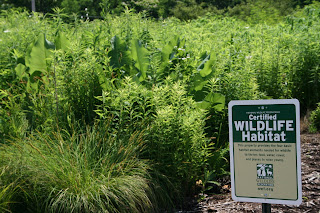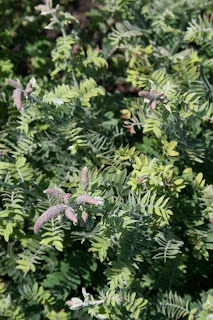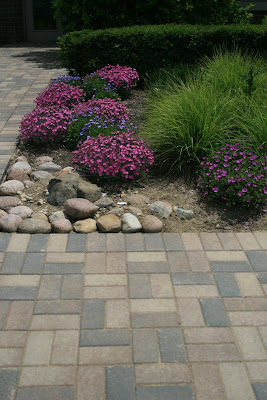It's that time of year; its hot, its muggy, and while we are sweaty and uncomfortable, the insect world is thriving. I am back this week for my second installment to talk about some very common issues now and in the next couple of weeks that might be plaguing your garden. First and foremost, I would like to introduce you the concept of degree days and what are called indicator plants. Degree days can be figured out in a number of ways, but I'll describe the most commonly used method which is called base 50. Degree days are the cumulative sum of the average temperatures in a given day minus 50. On a day like today, it is about 90 for our high and lets just say 70 for our low. The average of that is 80; subtract 50 and you have 30 DDB50 for that day. Each day is added to the prior and the cumulative number is the number of degree days you have at any given time. This is extremely useful information as it can be used to directly correlate phenological activity of 'indicator plants' to insect emergence. An example of an indicator plant is
catalpa sp. - it begins to bloom right around 500-600 DDB50 which is when euonymus scale is active. This is what we use in the nursery industry to determine what to spray and when. We see a specific plant blooming or at another stage and know that coorelates with a certain insects feeding time or stage in their life cycle. Below I will describe a number of pest issues and what plants you can look out for to determine if its the ideal time to treat that particular pest.
 Two spotted spider mite
Two spotted spider mite - this is one of the industries biggest pest. Along with aphids, more money goes into treating these little guys than any other single insect (actually its not an insect, its a mite). There are a variety of mites out there, but two-spotted spider mite is one of the most common and most damaging of them all. They are very small, about the size of a pencil tip, and can be found on the underside of leaves. They love both annuals and perennials alike and thrive in hot, dry weather. In a matter of days, a small population can explode into 1000s causing massive defoliation. The picture to the left displays some webbing, a tall-tale sign that they are present in extremely high numbers, if it gets to this point, you are better to just prune out the infected material. The individual mites suck the juices out of individual leaf cells causing small speckles all over the leaf, something we refer to as stipuling. It is unlikley they will kill any woody plant, but they could easily take out an annual such as geraniums or impatiens. For outside crops, look for this insect around the time
Spiraea 'vanhoutii' is done blooming (late May) through August. A simple oil or insecticidal soap will take care of small populations and plants with large populations should be discarded.
 Euonymus scale
Euonymus scale - this very tiy critter can cause massive damage to both upright and low growing euonymus species. It is what we call an armored scale (has a hard covering) which makes it impervious to chemical control. However, right around the time you see
Catalpa blooming, new eggs hatch and vulnerable 'crawlers' emerge. Crawlers are the immature stage of this insect and can be killed with oils, soaps, or insecticides. You can tell you have this problem if you are seeing die back, yellow spotting, or a general lack of growth on your euonymus. Look at the older growth and you might find small, white, elongated things stuck all over it. That is the scale under its covering sucking the sap from the stem. If left unchecked, this pest can kill a large shrub in one or two years. It tends to reproduce in extremley high numbers and the small 'crawlers' can blow onto other euonymus crops. Its importnat to look for this pest at the right time and when you see small, yellowish dots accompanying the larger white scale, its time to treat them.
 Viburnum borer -
Viburnum borer - each year I get more and more calls about this particular pest. Viburnum borer is a clear-wing wasp that is present right around this time (500-700 DDB50). The adult has yellow and black stripes, does not sting and actually does no damage to plants as an adult. However, when its ready in late June, it lays its eggs at the base of certain viburnum and in about 2-3 weeks, the eggs hatch and the small larvae begin tunneling into the trunk of the plant. Inside, they chew out a large piece of the xylem limiting nutrition and water uptake causing a portion of the plant to die off. If this problem persists, the plant will most likely die in 1 to 2 growing seasons. There is little you can do to prevent this problem, but buying a pest free, quality product to begin with is your best bet. this insect is attracted to stressed and dying specimens, so keeping a healthy viburnum will ensure that this problem will not happen to you. If you have viburnum that are not flushing out in the spring, check at the base around the soil level for a soft spot in the trunk - it will most likely be the pupating borer inside and at that point, the plant should be discarded and replaced.
 Black Vine Weevil -
Black Vine Weevil - the final insect I want to touch on is black vine weevil, a small (about the size of a penny) black beetle-like insect that chews notches in the edges of your leaves. It only feeds at night and will hide in and around leaf debris or large soil clots during the day. If you look closely at the picture, you can see how it has a long, squarish snout - this is important due to the fact that when it feeds, the damage is the same general shape as their mouth parts - squarish and always on the leaf edges. In general there is very little damage that the adults can do and what is done is generally aesthetic. However, in mid-summer an adult female will lay up to 250 eggs in the soil creating a number of grub-like larvae that chew on plant roots. If you have enough larvae present, they can kill a small plant through the fall and into the spring. Look for notched feeding on the edges of plants such as
euonymus, clethra, ittea, rosa sp, and other relativley soft leaved deciduous specimens (they also love
taxus). If you see feeding, purchase a general insecticide that is labeled for beetles and spray the leaves at dusk. This will ensure the adults are killed and are not able to reproduce and cause an even bigger problem.
I could go on for pages and pages on the many insects that we encounter in the nursery and in our gardens at home. These are a few that are present this time of year and can cause some significant problems. Utilizing degree day information from a local extension office (
http://ipm.illinois.edu/degreedays/) can help determine when to look for things and the best time to treat particular problems. The vast majority of insects are absolutley harmless and an essential part of the delicate balance of life, so dont assume that anything and everything is doing harm; most will do more good than anything. Buying a high quality product from a trusted source is always step one in keeping plants healthy and keeping them watered and fertilized will help keep any harmful critters at bay. I hope you enjoyed learning a little about insects and diseases, I sure had a good time talking about them; enjoy the rest of your summer!!!
 Vibrant, vivid purple blue, bright, energetic, excellent pairing Geranium Jolly Bee & Stachys Hummelo
Vibrant, vivid purple blue, bright, energetic, excellent pairing Geranium Jolly Bee & Stachys Hummelo Contrasting blue and yellow, primary colors, medium vibrancy
Contrasting blue and yellow, primary colors, medium vibrancy Yellow and pale lavendar, calming colors, pale hue - an improvement would be to eliminate the blue Veronica
Yellow and pale lavendar, calming colors, pale hue - an improvement would be to eliminate the blue Veronica Pair the next two plants for a vibrant, energizing coupling of pink on pink
Pair the next two plants for a vibrant, energizing coupling of pink on pink The Dark stemmed Echinacea is 'Pica Bella'
The Dark stemmed Echinacea is 'Pica Bella' A monochromatic relationship, lavendar, pink, purplish pink, all in the family - plus the unifying element of flower shape and form
A monochromatic relationship, lavendar, pink, purplish pink, all in the family - plus the unifying element of flower shape and form Shades of yellow into green, side by side on the color wheel, calming and refined
Shades of yellow into green, side by side on the color wheel, calming and refined
 An interesting exercise in the relationsip between pink and red. Red is often a challenge, especially in plants - is it red red, blue red, pink red or purple red? This photo illustrates the power of a color backdrop.
An interesting exercise in the relationsip between pink and red. Red is often a challenge, especially in plants - is it red red, blue red, pink red or purple red? This photo illustrates the power of a color backdrop. Pairing of orange foliage with orange flowers - the entire planting is offset with the Salvia's blue, great complimentary contrast, medium intensity of color pulls the entire composition together
Pairing of orange foliage with orange flowers - the entire planting is offset with the Salvia's blue, great complimentary contrast, medium intensity of color pulls the entire composition together



















 Oenothera 'Cold Crick'
Oenothera 'Cold Crick'





 Blue upon blue upon blue. Waves of repeated varying hues of blue and bluish purple. Repetition of similarly sized groupings. When Roy Diblik suggested placing multiple Salvia varieties beside each other within one planting, our first response was to ask why that was necessary. A Salvia is a Salvia right - and one is just as good as the other - why would you ever plant two nearly similar plants side by side? But we listened and we tried his suggestion and were amazed with the results. When you see them planted in a group, intermingling, slightly different bloom times, repetition of form and broad color with slight differences in hue, it is stunning. Try it!
Blue upon blue upon blue. Waves of repeated varying hues of blue and bluish purple. Repetition of similarly sized groupings. When Roy Diblik suggested placing multiple Salvia varieties beside each other within one planting, our first response was to ask why that was necessary. A Salvia is a Salvia right - and one is just as good as the other - why would you ever plant two nearly similar plants side by side? But we listened and we tried his suggestion and were amazed with the results. When you see them planted in a group, intermingling, slightly different bloom times, repetition of form and broad color with slight differences in hue, it is stunning. Try it!




 Chicagoland Grows introduction Baptisia Twilite PrairiebluesTM (above)
Chicagoland Grows introduction Baptisia Twilite PrairiebluesTM (above)